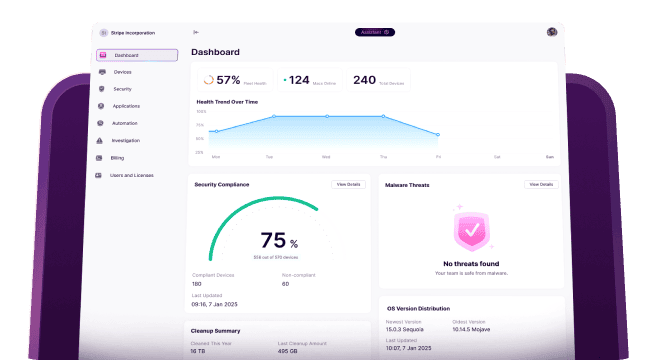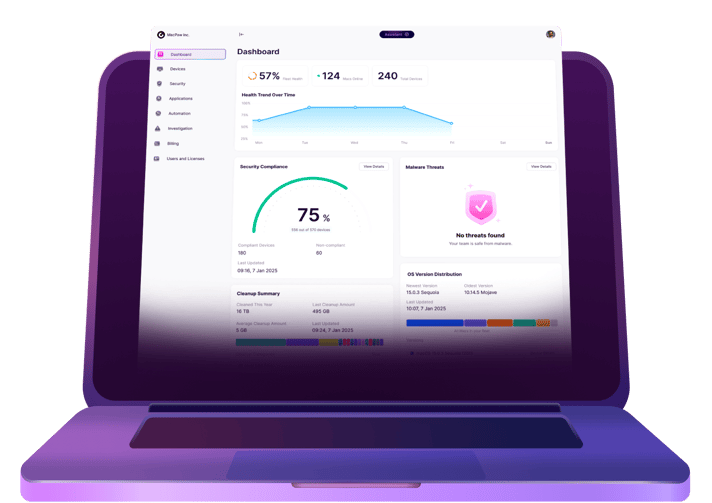As the most popular phone on the market, iPhones have cemented their place in the corporate environment. And as they become more powerful, people are starting to do more and more work from their pocket-sized devices. That means IT professionals need to know how to support them. More importantly, how to secure and manage them so that corporate data is secure regardless of how sensitive or confidential it may be.
That’s where remote management for iPhone comes in. This article will explain the benefits of iPhone management and what it allows you to do.
What is remote management for iPhone?
iPhones are obviously mobile devices. So, as your users are moving around and accessing corporate information on their phones, as the IT professional, you’ll need to make sure security policies are in place so that data isn’t leaked.
iOS remote management is simply the method that allows you to do that. To push software updates or restrict access, all remotely, without holding the phone in your hand.
How does a company benefit from iPhone management?
At this point, you might be thinking this all sounds pretty invasive and controlling. Why would you want to play Big Brother and spy on your employees’ devices? Well, the answer is that you need to. Besides, you already monitor and keep track of any corporate computer they’re issued. There shouldn’t be any difference with their iPhones.
Now, you’re probably wondering if this means your company needs to issue the employees all iPhones. Not necessarily. Keep reading, I’ll get to ownership models shortly.
iOS management tips
Great, so you’re on board with iPhone management in your enterprise environment. There are a couple of best practice tips you should consider and keep in mind as you start on this project.
Device ownership models
I told you we’d get to device ownership. So, do you have to buy your employees their own iPhones? No. But you can if you want to. There are two methods, and I’m sure you can assume what they are. However, I’ll briefly go over each to help you further decide which way will be suitable for your company.
User-owned devices
The biggest question about using user-owned devices is what happens to their personal data? Nothing. When managing an iOS device, you can create a profile that only sees corporate data. Some other benefits of this model include:
- Opt-in or out capabilities by the user
- User privacy
- Device personalization with their own Apple IDs.
Corporate-owned device
The prominent perk of a corporate-owned device is you get total control over it. That means you can automate enrollment into your services. You can also get full supervision over the devices, meaning you can route their internet traffic back through your internal network. That way, the device is always connected to your enterprise’s servers.
Managing content
Another power tool to consider is managing the device's content. Again, that doesn't mean you're restricting personal content. It just means if you have corporate apps, internet accounts, or even books that you want all of your employees to have, you can push them out with your remote management server.
Managing configuration
So, to run all of these great features, you’ll need some type of remote management software. Apple Configurator 2 is the native Apple tool made to do this. It’s great if you don’t have too many other systems and servers in your environment to worry about. But it’s not perfect for everybody. You may want a solution that will work for all of the computers in your environment. And if that’s the case, you might want to look into a third-party solution like JAMF.
Managed data flow
Depending on which remote manager or mobile device manager, MDM for short, you go with, you’ll have the option to manage data flow on your devices. That means you can restrict specific files from opening on certain networks or being transferred to specific apps. Here’s a quick list of things that you’d be able to manage:
- “Open in…” functionality
- Action extensions
- Custom keyboard functionality
- Allow in Today or Widgets
- Share extensions
What can I restrict with an iPhone work profile?
There are some other more general category restrictions you can implement. Those include:
- AirPrint
- App installation
- App usage
- Classroom app
- Device
- iCloud
- User and user group restrictions
- Safari
- Security and privacy settings
- Siri
There’s a lot more you can do with managed devices, and iPhone is such an invaluable tool for the workplace. But, in short, iPhone management is an incredibly powerful tool for any organization. It’s a great way to ensure devices are living up to the company’s security standards. iOS app management also ensures that every device has what it needs to function successfully. And you can do all of this without impacting or interfering with the user’s personal information.








